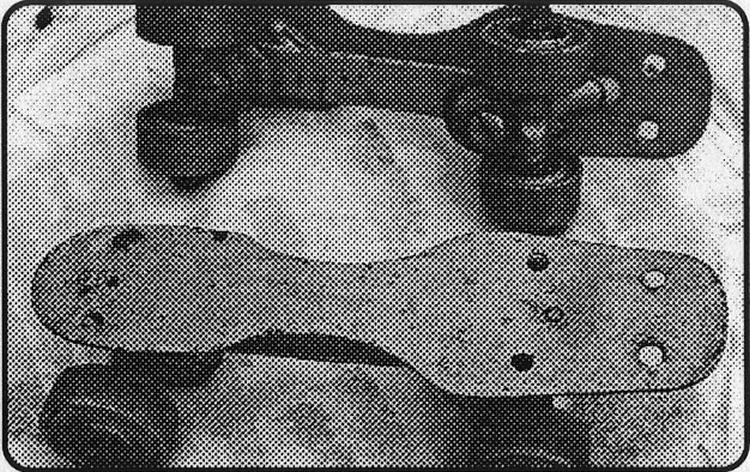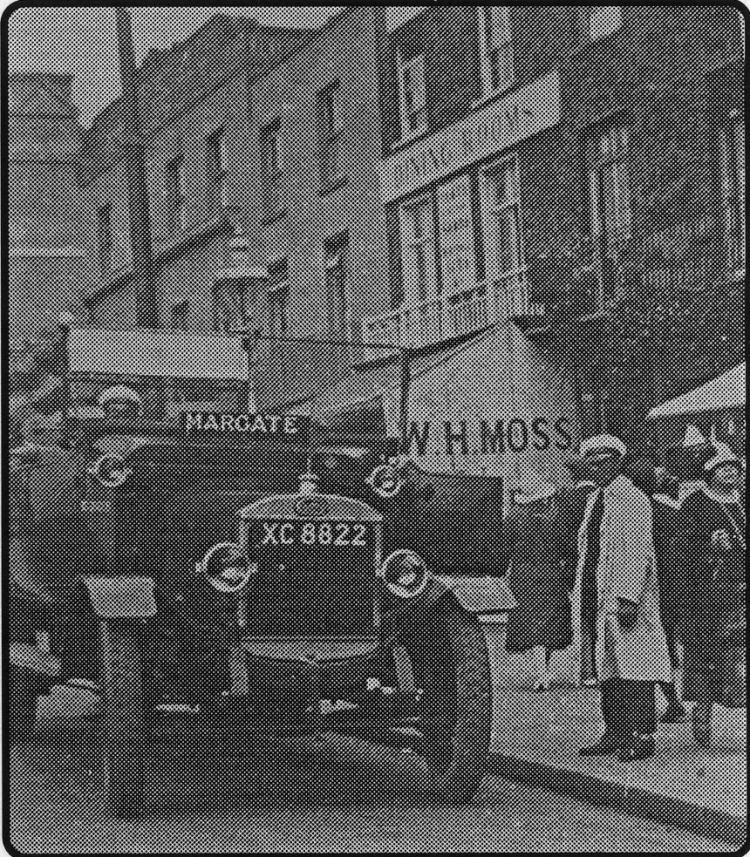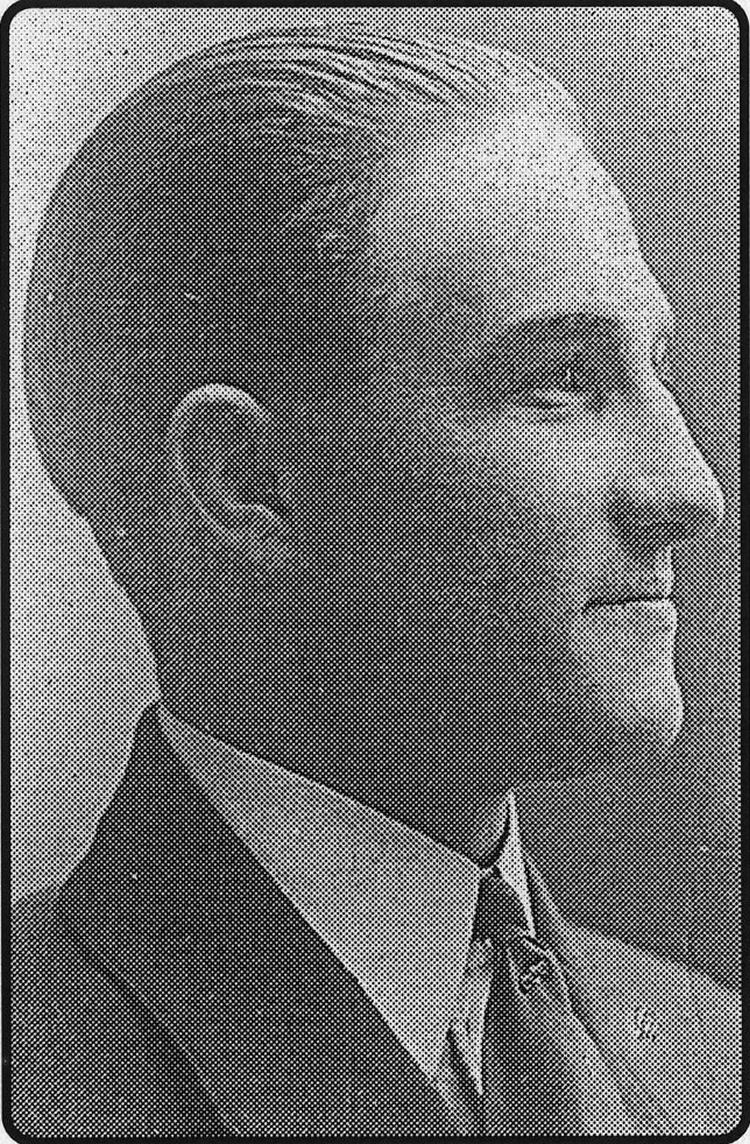
Published 12 July 2001



Poltergeist?
LOCAL history enthusiast Derrick Lawson, of Lynwood, Folkestone, is thinking
of presenting his uncle's skates, bought in the town in 1913, to the town
museum.
His extrovert uncle Harold Scowen, who served with the personnel of the
Airship Patrol at Capel airfield in the First World War, was once a champion
roller skater, Derrick told me, performing acrobatic stunts and somersaults
just as the young roller-bladers do today.
"Before my uncle joined the Royal Naval Air Service in 1916 he used these
skates many times on the old roller rink on the sea front and, with his
sister Cissy, won many prizes there - so much so the manager barred them
from all competitions!" he said.
Derrick, who used to work at Ashford Railway Works, says his first
recollection of meeting his uncle was during a visit to Plymouth in 1943
when Harold 'Cock' Scowen showed him the old pair of roller skates he bought
in Folkestone 30 years before.
"One day these will be yours!" said Harold. And later, shortly before he
died, his daughter, Barbara Scowen, told Derrick "Take them back to
Folkestone with you. Father would like that very much." Derrick Scowen was
then 17 or 18.
Derrick's grandmother Beatrice Scowen (nee Cockerton) was Harold's mother.
After service in the Royal Naval Air Service at Capel, when he was concerned
with scout balloons used for hunting enemy submarines in the Channel, Harold
Scowen was posted to another air ship station at Tregantle, in Cornwall.
"Since you have featured my uncle in Memories a couple of times recently,"
said Derrick, "I thought readers might like to see the all-metal skates so I
have taken a picture of them.
"Uncle never returned to Folkestone to live after demobilisation at the end
of the First War.
He married a Cornish girl and settled in the West Country."
Derrick also showed me his late Uncle Horace Buchan's picture of a bus he
drove to Margate in 1925. His uncle is in the driver's seat. "I wonder if
any reader knows whereabouts the photograph was taken?" said Derrick (tel:
242141.)
"My uncle worked for the charabanc owners for many years until he died in
1926," he said.
Incidentally Derrick's father Ernest Lawson was born in 69 Dover Street, a
property now demolished, which was steeped in the smuggling history of
Folkestone.
"That house was definitely haunted. The 17th Century property sat on a
mysterious network of tunnels known to riddle the Fishmarket area and these
were uncovered when the property was eventually demolished in the 1950s as
part of the redevelopment of the area," said Derrick.
Smugglers’ tunnels
The tunnels are thought to have been directly connected with smuggling
incidents described in the old Folkestone book "Smugglers and Smuggling
Days" published around 1883 and reprinted in 1967. This was written by John
English the one-time editor and owner of the old Folkestone Express
newspaper which came to an abrupt end when an adjoining property was bombed
in the Second World War and the offices and printing works were destroyed.
As to the "haunting" of the Dover Street house and poltergeist activity,
which have been highlighted in Memories before. Derrick told me how his
father, Ernest, at the age of 13, was about to start work on the railway.
"The night before he was due to report to Dover Priory Station he packed
some clothes in a case, which he placed under his bed.
"The following morning the case was open and
)
the contents strewn over the room!
"His parents told him not to worry because it was 'just the ghost playing
about'!"
And that was not an isolated incident, insists Derrick, who first visited
the house in the early 1930s when he was about six. He says the same sort of
thing happened at regular intervals in subsequent years, but the family just
grew to accept it. It sounds very much like poltergeist activity.
"One Christmas, when nearly all the family were present, vases on the old
Victorian style mantelpiece and heavy brass fire irons in the fender moved,
but nobody was worried - it was just the ghost at work!"
Small wonder then, that Derrick firmly believes in ghosts and loves to hear
of any local "haunt-ings."
When he was 11 years old he noticed the old fireclay kitchen sink of the
house was hinged to the wall and, puzzled about this, asked his grandmother
about it.
She explained that at one time smugglers lived in the house, said Derrick.
Beneath that sink was a trapdoor leading to an underground passage which led
a long way under the town. "Twice my grandfather, with his dog, explored the
passage," said Derrick "but he never found where it led. He was driven back
by the damp and cold!"
ABOVE: Derrick Lawson's uncle Harold Scowen. TOP: The skates the junior
champion roller skater wore; and, RIGHT: Horace Buchan at the wheel of an
outing charabanc, probably pictured in Thanet in 1925.
 |
Pig-headedness makes Hythe a ‘laughing stock’
A Q/%>1 ECONOMY run Mad at Hythe. read .L^Vs the headline above a Herald
writer's comment on the Council's decision to cut costs by taking the
"dangerous" step of keeping public lighting "turned down" all 24 hours
of the day -trusting to the moon to light the streets, supplemented by
shop lighting during opening hours. Felix said he had heard that local
people were laying in a stock of old-f.islnonud stable lanterns! Readers
also took up the theme, one "Lover of light” commenting that "when
evening sinks into sombre night we are groping about” in near darkness.
It was making Hythe the "laughing stock of the whole county" all because
of pig-headedness. And Folkestone Council did not fare much better the
Herald pointing out that there were repeated calls for prominent
direction signs to Important places, such as the railway stations, the
harbour, Warren, Leas, and neighbouring towns, but the council did
nothing. The School of Musketry team of eight won the prized Methuen Cup
at Bisley shooting at distances of 200, 500 and 600 yards. They scored
775 out of a possible 840.
|
Folkestone FC top Kent League for first time
*1 QEZ’I THE KENT League football champi-J.«79^onship came to Folkestone
for the first time in history 50 years ago this year. Folkestone FC with
52 points were left in an unassailable position when Snowdown. second in
the table, went down 4-0. at home, to Sittingbourne. Remarkably that
defeat ended a run of 25 matches without defeat. The Folkestone club had
been strong favourites to win the previous season, but the tough
challenge presented by a good showing in the Kent Senior Cup, in which
there were a series of replays, saw them finish runners-up to Ramsgate.
It was only the death of her sister-in-law. Mrs Elizabeth Fright, at 88,
that forced 101-year-old Miss Emma Fright, of School Road, Saltwood. to
go into a nursing home just before she was 101. Until then she had been
living with her brother William, also 88. and his wife in Saltwood. Mr
Fright had himself been confined to bed for several months. There
father, William, had been stationmaster at Hythe for 26 years. A long
service presentation, of a barometer, was made to Fred Anderson, who had
been a worker at the Advancc Laundry, in Stanley Road. Cheriton, for no
less than 52 years.
|
Narrow escapes as planes make emergency landings
iiQA/j THERE was drama at Scabrook when a big Dutch KLM air liner force
landed on the beach on its way from Rotterdam to Croydon with four
passengers. The engine coughed and spluttered to a halt while flying
over the Channel at 3,000 ft and Pilot Vandyke skilfully glided down to
land just beyond Battery Point. Neither he nor his passengers were hurt,
but Mr W Walters, of Sandgate, who was fishing from the beach had a
narrow escape. He was struck by a wing but sustained nothing worse than
a deep gash on his left leg. The same week a largo twin-engined Farman
Goliath crashed on Littlestone golf links and a twin-engined Handley
Page biplane force landed in Elms Vale, near Hougham. The day I heard on
my car radio that only a quarter of the mines laid during World War II
had been accounted for I looked up the Herald file for June 1926 and
noted the headline "Mine in the Channel" which told of the fifth mine
trawled up by Skipper A May of the Folkestone boat "Masterpiece." He was
four miles off Hythe when he 'caught' the 7001b hurn-less British mine.
He towed it very cautiously in the net to East Head sands where it was
cut free. The mine, of about 1916, was 'live' and would have been a
danger to ships in the fairway.
|
Plan for future of town now-or it will die warns Saga boss
>| ft *7/5 FOLKESTONE is dying - that was the shock JmSj I O warning
from Saga clmf Sidney de Haan. He said the town was in danger of
becoming like Highgate cemetery. What was needed, he believed was "men
of vision" to plan for the next five, 10 or 15 years. The town used to
be beautiful, he said, but had become an overgrown, crumbling wasteland,
the fault being it was designed "as a monument to the past.” He warned
that unless radical action was taken quickly the town would have no
future at all. "There is no plan for the future. There are few people
who seem to be prepared to plan five. 10 or 15 years ahead.” And he
added, "There seems little energy among our civic leaders to work, and
if necessary, to fight, to achieve a prosperous future for this area.
Indeed, it seems that representatives of Folkestone and of the rural
areas on Shepway District Council are more intent on fighting one
another." The town needed a plan for the future based on a mixed
economy, he said. The controversial bid to hold a major rock festival on
the former Battle of Britain airfield at Hawkinge met with a storm of
protests so it was a relief when the promoter had a change of plan to
switch the big festival to Gillingham and plan a smaller folk/rock event
at Hawkinge. The rock festival might have attracted a crowd of around
40.000. |
|




